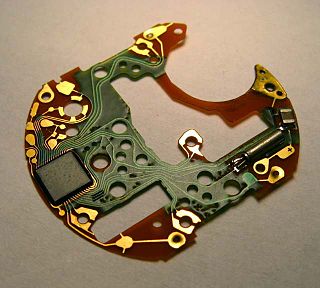Related Research Articles

A crystal oscillator is an electronic oscillator circuit that uses a piezoelectric crystal as a frequency-selective element. The oscillator frequency is often used to keep track of time, as in quartz wristwatches, to provide a stable clock signal for digital integrated circuits, and to stabilize frequencies for radio transmitters and receivers. The most common type of piezoelectric resonator used is a quartz crystal, so oscillator circuits incorporating them became known as crystal oscillators. However, other piezoelectric materials including polycrystalline ceramics are used in similar circuits.

Fever or pyrexia in humans is a body temperature above the normal range due to an increase in the body's temperature set point in the hypothalamus. There is no single agreed-upon upper limit for normal temperature: sources use values ranging between 37.2 and 38.3 °C in humans. The increase in set point triggers increased muscle contractions and causes a feeling of cold or chills. This results in greater heat production and efforts to conserve heat. When the set point temperature returns to normal, a person feels hot, becomes flushed, and may begin to sweat. Rarely a fever may trigger a febrile seizure, with this being more common in young children. Fevers do not typically go higher than 41 to 42 °C.

An electrical injury, or electrical shock is damage sustained to the skin or internal organs on direct contact with an electric current.

Barium oxide, also known as baria, is a white hygroscopic non-flammable compound with the formula BaO. It has a cubic structure and is used in cathode ray tubes, crown glass, and catalysts. It is harmful to human skin and if swallowed in large quantity causes irritation. Excessive quantities of barium oxide may lead to death.

Induction cooking is performed using direct electrical induction heating of cooking vessels, rather than relying on indirect radiation, convection, or thermal conduction. Induction cooking allows high power and very rapid increases in temperature to be achieved: changes in heat settings are instantaneous.
Enhanced SpeedStep is a series of dynamic frequency scaling technologies built into some Intel's microprocessors that allow the clock speed of the processor to be dynamically changed by software. This allows the processor to meet the instantaneous performance needs of the operation being performed, while minimizing power draw and heat generation. EIST was introduced in several Prescott 6 series in the first quarter of 2005, namely the Pentium 4 660. Intel Speed Shift Technology (SST) was introduced in Intel Skylake Processor.

A crystal oven is a temperature-controlled chamber used to maintain the quartz crystal in electronic crystal oscillators at a constant temperature, in order to prevent changes in the frequency due to variations in ambient temperature. An oscillator of this type is known as an oven-controlled crystal oscillator. This type of oscillator achieves the highest frequency stability possible with a crystal. They are typically used to control the frequency of radio transmitters, cellular base stations, military communications equipment, and for precision frequency measurement.

Aminophenazone is a non-narcotic analgesic substance. It is a pyrazolone and a derivative of phenazone, which also has anti-inflammatory and antipyretic properties. While inexpensive and effective, especially in the treatment of rheumatism, the drug carries a serious risk of severe and sometimes fatal side-effects, including agranulocytosis. While its production and use have been banned in many countries, including France, Thailand, India and Japan, it is still sometimes used in the developing world.

Maximum power point tracking (MPPT), or sometimes just power point tracking (PPT), is a technique used with variable power sources to maximize energy extraction as conditions vary. The technique is most commonly used with photovoltaic (PV) solar systems but can also be used with wind turbines, optical power transmission and thermophotovoltaics.
New York State Department of Health Code, Section 405, also known as the Libby Zion Law, is a regulation that limits the amount of resident physicians' work in New York State hospitals to roughly 80 hours per week. The law was named after Libby Zion, the daughter of author Sidney Zion, who died in 1984 at the age of 18. Sidney blamed Libby's death on overworked resident physicians and intern physicians. In July 2003, the Accreditation Council for Graduate Medical Education adopted similar regulations for all accredited medical training institutions in the United States.
Normal human body temperature is the typical temperature range found in humans. The normal human body temperature range is typically stated as 36.5–37.5 °C (97.7–99.5 °F).
Targeted temperature management (TTM) previously known as therapeutic hypothermia or protective hypothermia is an active treatment that tries to achieve and maintain a specific body temperature in a person for a specific duration of time in an effort to improve health outcomes during recovery after a period of stopped blood flow to the brain. This is done in an attempt to reduce the risk of tissue injury following lack of blood flow. Periods of poor blood flow may be due to cardiac arrest or the blockage of an artery by a clot as in the case of a stroke.

Carl von Liebermeister was a German internist who was a native of Ronsdorf.

The kelvin, symbol K, is the base unit of measurement for temperature in the International System of Units (SI). The Kelvin scale is an absolute temperature scale that starts from 0 K, the lowest possible temperature, then rises by exactly 1 K for each 1 °C. The Kelvin scale was designed to be easily converted from the Celsius scale. Any temperature in degrees Celsius can be converted to kelvin by adding 273.15.

Quartz clocks and quartz watches are timepieces that use an electronic oscillator regulated by a quartz crystal to keep time. This crystal oscillator creates a signal with very precise frequency, so that quartz clocks and watches are at least an order of magnitude more accurate than mechanical clocks. Generally, some form of digital logic counts the cycles of this signal and provides a numerical time display, usually in units of hours, minutes, and seconds.

The Red Bull RB5 is a Formula One racing car designed by the Red Bull Racing team for the 2009 Formula One season. It was driven by Sebastian Vettel, who drove for Red Bull's sister team Toro Rosso in the 2008 season, and Mark Webber. The car was launched on 9 February 2009 at the Circuito de Jerez in Spain.
Febrile non-hemolytic transfusion reaction (FNHTR) is the most common type of transfusion reaction. It is a benign occurrence with symptoms that include fever but not directly related with hemolysis. It is caused by cytokine release from leukocytes within the donor product as a consequence of white blood cell breakdown .These inflammatory mediators accumulate during the storage of the donated blood, and so the frequency of this reaction increases with the storage length of donated blood. This is in contrast to transfusion-associated acute lung injury, in which the donor plasma has antibodies directed against the recipient HLA antigens, mediating the characteristic lung damage.

The 2009 Bolivian dengue fever epidemic was an epidemic of dengue fever which struck Bolivia in early 2009, escalating into a national emergency by February. The BBC described it as the worst outbreak of dengue fever in the country's history. At least 18 people died and 31,000 were infected by the mosquito-transmitted arbovirus.
DramaFever was a video streaming website owned by Warner Bros. that offered on-demand streaming video of documentaries, movies, and TV shows with subtitles. DramaFever's content offering was both ad-supported for regular users and available in high definition for premium subscribers.

Film capacitors, plastic film capacitors, film dielectric capacitors, or polymer film capacitors, generically called film caps as well as power film capacitors, are electrical capacitors with an insulating plastic film as the dielectric, sometimes combined with paper as carrier of the electrodes.
References
- ↑ "Liebermeister's rule". www.whonamedit.com. Retrieved 2009-09-02.
- ↑ "mondofacto dictionary - definition of Liebermeister's rule". Mondofacto.com. 2000-03-05. Archived from the original on 2016-03-03. Retrieved 2009-09-02.